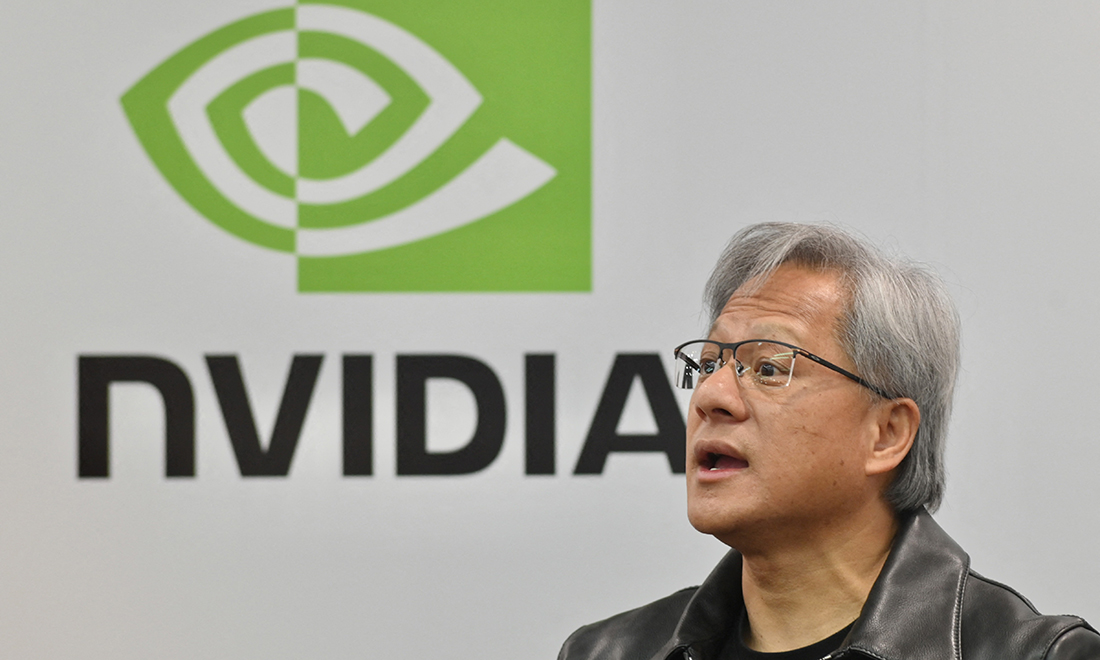
2024年2月22日,英伟达(Nvidia)股票的单日涨幅创下了资本市场历史上的最新纪录。到上午10点,英伟达的股价暴涨约15%,其市值从前一个交易日收盘时的1.66万亿美元增长到1.91万亿美元。新增的2,500亿美元市值相当于特斯拉(Tesla)市值的40%、甲骨文(Oracle)的80%,比英特尔(Intel)的市值多出20%。如今,英伟达在投资界有举足轻重的影响力。英伟达在2月21日收盘后发布的业绩超出预期,让市场陷入疯狂,到22日下午3点左右,纳斯达克100指数(Nasdaq 100)暴涨3%。
华尔街分析师对英伟达的业绩欢欣鼓舞,至少有18家证券经纪公司上调了对英伟达到2024年年底的股价涨幅的预测。其目前的股价接近800美元。高盛集团(Goldman Sachs)将对英伟达的股价预测提高到875美元,伯恩斯坦(Bernstein)提高到1,000美元,而KeyBanc则提高到1,100美元。
这种乐观的态度当然可以理解,因为英伟达不仅取得了非凡的业绩,还有一种普遍观点认为,英伟达占据主导地位的人工智能领域,将是这个千年的颠覆性技术。在2024财年(截至1月31日),英伟达按公认会计准则(GAAP)计算的营收增长126%,达到610亿美元,净收益增长近六倍,达到298亿美元。英伟达展现出前所未有的大规模运营杠杆效应,这意味着公司新增利润在新增收入中占较大比例。例如,英伟达的毛利润率提高了57%,达到73%,这表明通过对比商品售价与公司为生产或采购产品和原材料支付的成本,英伟达向客户提供的每一件可比商品的利润比2023年提高了30%。还有更好的消息。扣除特殊项目以外,英伟达的研发、日常开支和其他运营成本仅上涨了11%,只有销售额增长幅度的十分之一。
虽然业绩令人瞩目,但未来收益的门槛已经被大幅提高
分析师指出,英伟达的市盈率倍数并没有高到离谱。在英伟达的股价于2月22日大幅上涨之前,根据其2024财年全年的收益298亿美元计算,其市盈率为56倍,而华尔街的分析师们根据对未来几个季度巨大收益的远期预估,使用了更低的市盈率倍数。一夜之间,股价大涨15%把英伟达的市盈率倍数提高到64。在投资界,没有人会对这个数字感到担心。
值得关注的是,对英伟达在未来十年为维持当前1.91万亿美元的市值需要实现的收益水平的预测。事实上,有趣的是探究此次史无前例的单日涨幅,将收益门槛提高了多少。假如投资者希望英伟达能够实现10%的年度总回报率。毕竟,这是一只高风险的股票。在英伟达公布业绩之前的期权活动表明,投资者非常担心即使公司业绩稍微差强人意,都可能影响股价,因为市场对其股价有极高的预期。
将2月21日英伟达市值为1.66万亿美元时需要产生的收益,与目前市值增加2,400亿美元之后需要产生的收益进行对比,得出的结果非常有趣。
首先我们来计算在此次股价大涨之前,英伟达如何实现10%的年回报率。当英伟达的市值为1.66万亿美元时,到2034年其估值必须达到4.33万亿美元,才可以实现我们的回报率目标。假设到那时英伟达依旧能够维持快速增长但趋于成熟,我们假定它的市盈率是高于平均水平的25倍。在这种情况下,未来十年英伟达的利润需要达到1,730亿美元,才可以实现10%的回报率目标。这相当于平均年利润增长率为18.9%。
这已经非常难以实现。但在2月22日,情况变得更加夸张。按当前的1.91万亿美元的市值和我们假定的25倍市盈率,到2034年英伟达需要实现的利润不是1,730亿美元,而是2,000亿美元。这是苹果和微软目前不到1,000亿美元利润的两倍之多。按未来十年2.5%的年通胀率进行调整,这个数字比苹果过去四个季度的收益多出50%。到2034年利润达到2,000亿美元,需要维持21%的年利润增长率,这比2月22日股价大涨之前需要达到的18.9%的年增长率高出2.1个百分点。
这两个数字听起来或许差异不大。但要知道,从2033年到2034年,要实现年度利润增长21%,英伟达的净收益需要在一年内增长350亿美元。相比之下,按前一天1.66万亿美元的市值(低了15%),到第十年年度净收益需要增长270亿美元。
简而言之,问题不在于21%的利润增长率,对科技巨头们而言,这并非遥不可及。问题在于英伟达已经赚取了大量收益,而且市盈率倍数较高。值得警惕的是:英伟达未来要为投资者带来丰厚回报需要实现的利润,以及未来需要维持的150亿美元、200亿美元甚至350亿美元的年增长幅度。竞争对手将会争相抢占其丰厚的利润,更激烈的竞争会导致价格和盈利能力下跌。最近创纪录的股价上涨,只会让英伟达必须面对的挑战变得更加艰巨。没有任何一家公司能够像英伟达这样快速取得惊人的业绩,也没有一家公司可以达到英伟达这样的高度,能够克服大数定律。(财富中文网)
译者:刘进龙
审校:汪皓
2024年2月22日,英伟达(Nvidia)股票的单日涨幅创下了资本市场历史上的最新纪录。到上午10点,英伟达的股价暴涨约15%,其市值从前一个交易日收盘时的1.66万亿美元增长到1.91万亿美元。新增的2,500亿美元市值相当于特斯拉(Tesla)市值的40%、甲骨文(Oracle)的80%,比英特尔(Intel)的市值多出20%。如今,英伟达在投资界有举足轻重的影响力。英伟达在2月21日收盘后发布的业绩超出预期,让市场陷入疯狂,到22日下午3点左右,纳斯达克100指数(Nasdaq 100)暴涨3%。
华尔街分析师对英伟达的业绩欢欣鼓舞,至少有18家证券经纪公司上调了对英伟达到2024年年底的股价涨幅的预测。其目前的股价接近800美元。高盛集团(Goldman Sachs)将对英伟达的股价预测提高到875美元,伯恩斯坦(Bernstein)提高到1,000美元,而KeyBanc则提高到1,100美元。
这种乐观的态度当然可以理解,因为英伟达不仅取得了非凡的业绩,还有一种普遍观点认为,英伟达占据主导地位的人工智能领域,将是这个千年的颠覆性技术。在2024财年(截至1月31日),英伟达按公认会计准则(GAAP)计算的营收增长126%,达到610亿美元,净收益增长近六倍,达到298亿美元。英伟达展现出前所未有的大规模运营杠杆效应,这意味着公司新增利润在新增收入中占较大比例。例如,英伟达的毛利润率提高了57%,达到73%,这表明通过对比商品售价与公司为生产或采购产品和原材料支付的成本,英伟达向客户提供的每一件可比商品的利润比2023年提高了30%。还有更好的消息。扣除特殊项目以外,英伟达的研发、日常开支和其他运营成本仅上涨了11%,只有销售额增长幅度的十分之一。
虽然业绩令人瞩目,但未来收益的门槛已经被大幅提高
分析师指出,英伟达的市盈率倍数并没有高到离谱。在英伟达的股价于2月22日大幅上涨之前,根据其2024财年全年的收益298亿美元计算,其市盈率为56倍,而华尔街的分析师们根据对未来几个季度巨大收益的远期预估,使用了更低的市盈率倍数。一夜之间,股价大涨15%把英伟达的市盈率倍数提高到64。在投资界,没有人会对这个数字感到担心。
值得关注的是,对英伟达在未来十年为维持当前1.91万亿美元的市值需要实现的收益水平的预测。事实上,有趣的是探究此次史无前例的单日涨幅,将收益门槛提高了多少。假如投资者希望英伟达能够实现10%的年度总回报率。毕竟,这是一只高风险的股票。在英伟达公布业绩之前的期权活动表明,投资者非常担心即使公司业绩稍微差强人意,都可能影响股价,因为市场对其股价有极高的预期。
将2月21日英伟达市值为1.66万亿美元时需要产生的收益,与目前市值增加2,400亿美元之后需要产生的收益进行对比,得出的结果非常有趣。
首先我们来计算在此次股价大涨之前,英伟达如何实现10%的年回报率。当英伟达的市值为1.66万亿美元时,到2034年其估值必须达到4.33万亿美元,才可以实现我们的回报率目标。假设到那时英伟达依旧能够维持快速增长但趋于成熟,我们假定它的市盈率是高于平均水平的25倍。在这种情况下,未来十年英伟达的利润需要达到1,730亿美元,才可以实现10%的回报率目标。这相当于平均年利润增长率为18.9%。
这已经非常难以实现。但在2月22日,情况变得更加夸张。按当前的1.91万亿美元的市值和我们假定的25倍市盈率,到2034年英伟达需要实现的利润不是1,730亿美元,而是2,000亿美元。这是苹果和微软目前不到1,000亿美元利润的两倍之多。按未来十年2.5%的年通胀率进行调整,这个数字比苹果过去四个季度的收益多出50%。到2034年利润达到2,000亿美元,需要维持21%的年利润增长率,这比2月22日股价大涨之前需要达到的18.9%的年增长率高出2.1个百分点。
这两个数字听起来或许差异不大。但要知道,从2033年到2034年,要实现年度利润增长21%,英伟达的净收益需要在一年内增长350亿美元。相比之下,按前一天1.66万亿美元的市值(低了15%),到第十年年度净收益需要增长270亿美元。
简而言之,问题不在于21%的利润增长率,对科技巨头们而言,这并非遥不可及。问题在于英伟达已经赚取了大量收益,而且市盈率倍数较高。值得警惕的是:英伟达未来要为投资者带来丰厚回报需要实现的利润,以及未来需要维持的150亿美元、200亿美元甚至350亿美元的年增长幅度。竞争对手将会争相抢占其丰厚的利润,更激烈的竞争会导致价格和盈利能力下跌。最近创纪录的股价上涨,只会让英伟达必须面对的挑战变得更加艰巨。没有任何一家公司能够像英伟达这样快速取得惊人的业绩,也没有一家公司可以达到英伟达这样的高度,能够克服大数定律。(财富中文网)
译者:刘进龙
审校:汪皓
On Feb. 22, 2024, Nvidia’s stock performed one-day heroics probably never matched in the annals of capitalism. By 10 a.m., its shares had soared almost 15%, lifting its market capitalization to $1.91 trillion from $1.66 trillion at the previous close. The gain of $250 billion equals 40% the valuation for Tesla and 80% that of Oracle, and exceeds the worth of Intel by 20%. Nvidia is now the straw stirring the cocktail in the investment world. Its earnings beat, reported after the market close on Feb. 21, ignited a frenzy that sent the Nasdaq 100 soaring 3% by midafternoon on the 22nd.
Wall Street analysts cheered the results, with no fewer than 18 brokerages lifting their forecasts for gains beyond its current price of almost $800 by year-end. Goldman Sachs hiked to $875, while Bernstein raised to $1,000 and KeyBanc to $1,100.
The optimism is certainly understandable, given Nvidia’s sorcerous results, and the widespread view that the AI domain it dominates will prove the transformative technology of the millennium. For FY 2024 (ended Jan. 31), Nvidia grew GAAP revenues by 126% to $61 billion, and raised net income almost sixfold, to $29.8 billion. Nvidia is exhibiting operating leverage on a scale probably never before witnessed, meaning that it is booking big earnings increases as a share of every dollar of new revenue. For example, the gross margin rise of 57% to 73% shows that Nvidia this year pocketed 30% more on each comparable unit shipped to customers over last year, based on the selling price versus what it paid to make or purchase the products and materials. It gets better. Its R&D, overhead and other operating costs, less special items, rose a piddling 11%, one-tenth the rate of increase in its sales.
Despite those spectacular results, the bar just jumped enormously for future earnings
Analysts point out that Nvidia’s P/E multiple doesn’t look outrageous. Prior to the jump on February 22, it stood at 56 based on full FY 2024 earnings of $29.8 billion, and the Wall Street crowd used much lower numbers by citing forward estimates incorporating giant gains in the quarters to come. Overnight, the 15% jump in its share price raised Nvidia’s multiple to 64. In the investment community, that substantial figure appears to scare almost no one.
What should give pause is projections on what Nvidia will need to earn, say, a decade hence to be worth anything like its current cap of $1.91 trillion. In fact, it’s interesting to examine just how much the historic one day leap has raised the bar. Let’s say investors will want a 10% annual total return from Nvidia. After all, it’s a risky stock. The options action prior to the earnings release underscored that investors were extremely nervous that even mildly disappointing results would hammer the stock, simply because of the great expectations built into the price.
It’s especially interesting to compare the earnings Nvidia would have needed to generate when its market cap was $1.66 trillion in February 21 compared to the requirements today, after adding $240 billion.
So let’s start with what was required before the mega-bump, to reach returns of 10% a year. When Nvidia’s cap was $1.66 trillion, it had to notch a valuation of $4.33 trillion by 2034 to reach our goal. Assuming that by then it’s still growing pretty fast, but heading for maturity, we’ll assume it boasts a better-than-average PE of 25. In that scenario, the profit needed to grab the prize is $173 billion 10 years hence. Getting there equates to 18.9% yearly growth in profits, on average, over that span.
That’s one heck of a stretch. But on February 22, the stretch got a lot more elastic. At the current $1.91 trillion cap and our 25 assumption for a P/E, Nvidia must make not $173 billion, but $200 billion by 2034. That’s well over twice the sub-$100 billion numbers Apple and Microsoft are showing today. Adjusted for 2.5% yearly inflation over the next decade, it’s 50% more than Apple earned in the last four quarters. Hitting the $200 billion mark in 2034 requires annual increases of 21%, 2.1 points more than the 18.9% needed before the February 22 run-up.
That may not sound like a huge difference. But consider this: In 2034 over 2033, to add that annualized 21% in profits, Nvidia’s net income would need to wax, in a single year, by $35 billion. That compares with an increase in that 10th year of $27 billion just a day ago, when its valuation was 15% lower at $1.66 trillion.
Put simply, the problem isn’t that 21% earnings growth, for the tech superstar of superstars, looks so daunting. It’s that Nvidia already earns tons of money, and sells at a big multiple to those fat earnings. The cause for caution: The ultimate number Nvidia must achieve to give investors decent returns from here, and the multiple $15 or $20 and eventually $35 billion increases needed in the out years. Competitors will jump rush to capture a share of its sumptuous margins. Stiffer competition will cause prices and profitability to drop. The latest surge just made the adjustable mountain Nvidia must climb far steeper. No company has ever delivered such astounding results so quickly as Nvidia. And no company has ever had to scale such formidable heights to surmount the law of large numbers.






